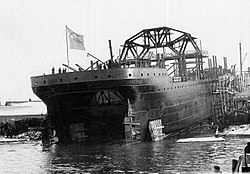
The Russian navy is the naval arm of the Russian Armed Forces. It has existed in various forms since 1696; its present iteration was formed in January 1992 when it succeeded the Navy of the Commonwealth of Independent States.

The Soviet Navy was the naval warfare uniform service branch of the Soviet Armed Forces. Often referred to as the Red Fleet, the Soviet Navy made up a large part of the Soviet Union's strategic planning in the event of a conflict with the opposing superpower, the United States, during the Cold War (1945–1991). The Soviet Navy played a large role during the Cold War, either confronting the North Atlantic Treaty Organization in western Europe or power projection to maintain its sphere of influence in eastern Europe.
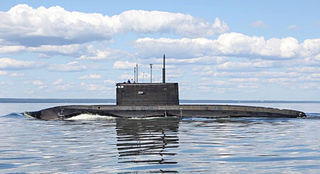
The Kilo-class submarines are a group of diesel-electric attack submarines designed by the Rubin Design Bureau in the Soviet Union in the 1970s and built originally for the Soviet Navy.

The Black Sea Fleet is the fleet of the Russian Navy in the Black Sea, the Sea of Azov and the Mediterranean Sea. The Black Sea Fleet, along with other Russian ground and air forces on the Crimean Peninsula, are subordinate to the Southern Military District of the Russian Armed Forces. The fleet traces its history to its founding by Prince Potemkin on 13 May 1783 as part of the Imperial Russian Navy. The Russian SFSR inherited the fleet in 1918; with the founding of the Soviet Union in 1922, it became part of the Soviet Navy. Following the collapse of the Soviet Union in 1991, the Black Sea Fleet was partitioned between the Russian Federation and Ukraine in 1997, with Russia receiving title to 82% of the vessels.

The Baltic Fleet is the fleet of the Russian Navy in the Baltic Sea.

A deep-submergence rescue vehicle (DSRV) is a type of deep-submergence vehicle used for rescue of personnel from disabled submarines and submersibles. While DSRV is the term most often used by the United States Navy, other nations have different designations for their equivalent vehicles.

The Kirov Plant, Kirov Factory or Leningrad Kirov Plant (LKZ) is a major Russian mechanical engineering and agricultural machinery manufacturing plant in St. Petersburg, Russia. It was established in 1789, then moved to its present site in 1801 as a foundry for cannonballs. The Kirov Plant is sometimes confused with another Leningrad heavy weapons manufacturer, Factory No. 185 . Recently the main production of the company is Kirovets heavy tractors.

Moskva, formerly Slava, was a guided missile cruiser of the Russian Navy. Commissioned in 1983, she was the lead ship of the Project 1164 Atlant class, named after the city of Moscow. With a crew of 510, Moskva was the flagship of the Black Sea Fleet and the most powerful warship in the region.

Russian cruiser Varyag, formerly Chervona Ukraina, is the third ship of the Slava-class of guided missile cruisers built for the Soviet Navy now serving the Russian Navy.
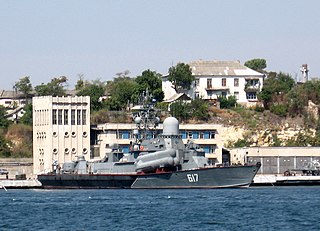
The Battle off the coast of Abkhazia was a supposed naval engagement between warships of the Russian Black Sea Fleet and Georgian patrol boats during the Russo-Georgian War.
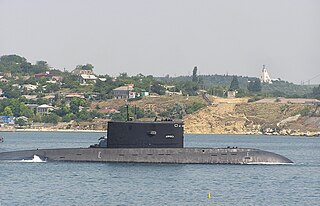
The Russian submarine B-871 Alrosa is a diesel-electric Kilo-class submarine that joined the Soviet Navy in 1990 and was active with the Russian Navy's Black Sea Fleet. B-871 Alrosa was laid down on 17 May 1988 at the Gorky shipyard. The submarine was launched on 10 September 1989 and commissioned on 1 December 1990. In 1991, during the dissolution of the Soviet Union, the crew of the boat swore allegiance to Ukraine. Though in Ukrainian service, the submarine saw limited duty due to a lack of parts. The vessel returned to Russian service in 1997 as part of an agreement between the two nations.
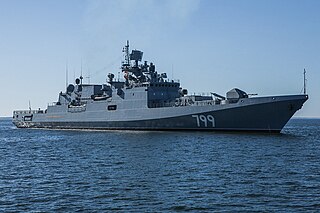
Admiral Makarov is an Admiral Grigorovich-class frigate of the Russian Navy, part of the Black Sea Fleet based at Sevastopol. She was laid down at the Yantar Shipyard in February 2012 and commissioned on 25 December 2017. She is the most recently built of her class, and the third of six ships that had been planned in the class as of November 2014.

R-360 Neptune is a Ukrainian subsonic cruise missile with all-weather capabilities developed by the Luch Design Bureau in Kyiv. Originally designed as an anti-ship missile, an alternative model was fielded in 2023 with a new guidance system to support land-attack roles. With a range of over 200 kilometres, it is intended to neutralize naval targets up to 9,000 tonnes.
In the 9th century, the Kievan Rus' had a powerful naval fleet, as shown by their successful siege of Constantinople in 860. However, the fleet was irregular and primarily used for raids. The Mongol Empire's destructive invasion and weaknesses in the fleet led to its dissolution, except for the Principality of Novgorod, which had access to open seas and avoided Mongol invasions. In the 14th century, Novgorod pirates terrorized nearby regions. The Grand Duchy of Moscow, the first proper Russian state, gained access to open waters and marked the beginning of the Golden Age of the Russian Navy. In 1570, Ivan the Terrible created a flotilla to protect Russian navigation in the Baltic Sea, which lasted for about a year. In the 16th century, Russia fought against the Ottoman Empire to gain free access to the Black Sea. In the 17th century, Russian sailors explored the Arctic Ocean and reached the Pacific Ocean, with Semyon Dezhnev discovering the Bering Strait. Naval operations took place during the Russo-Swedish War.

Vasily Bykov is a project 22160 patrol ship of the Russian Navy, of which it was the first ship built. It was laid down on 26 February 2014 on the Zelenodolsk Shipyard at Zelenodolsk in Tatarstan, Russia, and launched on 28 August 2017. Vasily Bykov was commissioned on 20 December 2018 in the Novorossiysk Naval Base at Novorossiysk, becoming part of the Black Sea Fleet.

The Russian warship Moskva, the flagship of the Russian Navy's Black Sea Fleet, sank on 14 April 2022 during the Russian invasion of Ukraine. Ukrainian officials announced that their forces had hit and damaged it with two R-360 Neptune anti-ship missiles, and that the ship had then caught fire. The United States Department of Defense later confirmed this, and Russia reported that the ship had sunk in stormy seas after the fire reached munitions onboard and they exploded.
Vsevolod Bobrov is an Elbruss-class in the Russian Navy. Built by the Severnaya Verf Shipyard from 2013 to 2021, the ship is used for transporting dry cargo, water, and ammunition, as well as providing search-and-rescue, medical support, and towing capabilities. The ship was named after the Soviet football and ice hockey player Vsevolod Bobrov.

